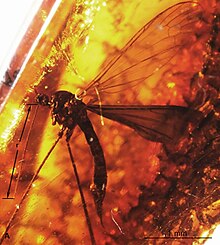Elephantomyia brevipalpa
|
Elephantomyia brevipalpa Temporal range: Middle Eocene |
|
|---|---|
 |
|
| E. (E.) brevipalpa female | |
| Scientific classification | |
| Kingdom: | Animalia |
| Phylum: | Arthropoda |
| Class: | Insecta |
| Order: | Diptera |
| Family: | Limoniidae |
| Genus: | Elephantomyia |
| Species: | †E. brevipalpa |
| Binomial name | |
|
Elephantomyia brevipalpa (Loew, 1850) |
|
| Synonyms | |
|
|
Elephantomyia (Elephantomyia) brevipalpa is an extinct species of crane fly in the family Limoniidae. The species is solely known from the Middle EoceneBaltic amber deposits in the Baltic Sea region of Europe. The species is one of six described from Baltic amber.
Elephantomyia (Elephantomyia) brevipalpa is known from the holotype specimen, collection number MB.J.337, along with two further adults which are preserved as inclusions in transparent Baltic amber. As of 2015, two of the amber specimens were included in the collections of the University of Göttingen, while the third was housed at the Polish Academy of Sciences. Baltic amber is recovered from fossil bearing rocks in the Baltic Sea region of Europe. Estimates of the age date between 37 million years old, for the youngest sediments and 48 million years old. This age range straddles the middle Eocene, ranging from near the beginning of the Lutetian to the beginning of the Pribonian. E. brevipalpa is one of six crane fly species in the genus Elephantomyia described from the Baltic amber, the others being E. baltica, E. bozenae, E. irinae, E. longirostris, and E. pulchella. All six species are placed into the Elephantomyia subgenus Elephantomyia based on the lack of tibial spurs and by several aspects of the wing morphology.
The fossil was first studied by entomologist Hermann Loew of the Germany, with his type description of the new species being published in 1851 as Toxorhina brevipalpa, though he published the nomen nudum name a year earlier. The species was moved to the genus Limnobiorhynchus in 1860 by Carl Robert Osten-Sacken, and later moved by Osten-Sacken again, this time to the genus Elephantomyia. The fossil was reexamined and the species redescribed in 2015 by paleoentomologist Iwona Kania of the University of Rzeszów, who examined the holotype and the two additional specimens.
...
Wikipedia
